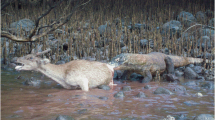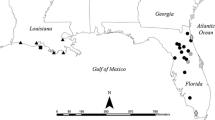Abstract
The feeding niche ofColostethus stepheni changes during ontogeny. Small individuals eat small arthropods, principally mites and collembolans, and larger frogs eat bigger prey of other types. The shift in prey types is not a passive effect of selection for bigger prey. There is a strong relationship between electivity for prey types and frog size, independent of electivity for prey size. Four indices of general activity during foraging (number of movements, velocity, total area utilized and time spent moving), which are associated with electivity for prey types in adult frogs and lizards, did not predict the ontogenetic change in the diet ofC. stepheni. Apparently, the behavioral changes that cause the ontogenetic change inC. stepheni are more subtle than shifts in general activity during foraging. Studies of niche partitioning in communities of anurans that do not take into consideration ontogenetic changes in diet and seasonal changes in the size structures of populations present a partial and possibly erroneous picture of the potential interactions among species.
Similar content being viewed by others
References
Allmon WD (1991) A plot study of florest floor litter frogs, Central Amazon, Brazil. J Trop Ecol 7:503–522
Christian KA (1982) Change in the food niche during postmetamorphic ontogeny of the frogPseudacris triseriata. Copeia 1982:73–80
Clark DB, Gibbons JW (1969) Dietary shifts in the turtlePseudemys scripta (Schoepff) from youth to maturity. Copeia 1969:704–6
Domínguez JF, Salvador A (1990) Disponibilidad y uso de recursos tróficos porLacerta schreiberi yPodarcis bocagei en simpatria en una localidad de la Cordillera Cantábrica, España. Amphibia-Reptilia 11:237–246
Donnelly MA (1991) Feeding patterns of the strawberry poison frog,Dendrobates pumilio (Anura: Dendrobatidae). Copeia 1991:723–730
Griffiths D (1975) Prey availability and the food of predators. Ecology 56:1209–1214
Grossman GD (1980) Ecological aspects of ontogenetic shifts in prey size utilization in the bay goby (Pisces: Gobiidae). Oecologia 47:233–238
Guillaumet JL (1987) Some structural and floristic aspects of the forest. Experientia 43:241–251
Huey RB, Pianka ER (1981) Ecological consequences of foraging mode. Ecology 64:991–999
Jacobs J (1974) Quantitative measurement of food selection: A modification of the forage ratio and Ivlev's electivity index. Oecologia 14:413–417
Junca FA (1989) Biologia reprodutiva deColostethus marchesianus eColostethus sp. (Amphibia: Anura: Dendrobatidae). In: Christoffersen ML, Amorim DS (eds). Resumos XVI Congresso Brasileiro de Zoologia. João Pessoa, Paraiba, p 64
Labanick GM (1976) Prey availability, consumption and selection in the cricket frog,Acris crepitans (Amphibia, Anura: Hylidae). J Herpetol 10:293–298
Lieberman SS (1986) Ecology of the leaf litter herpetofauna of a Neotropical rain forest: La Selva, Costa Rica. Acta Zool Mex 15:1–72
Magnusson WE, Paiva LJ, Rocha RM, Francke CR, Kasper LA, Lima AP (1985) The correlates of foraging mode in a community of Brazilian lizards. Herpetologica 4:324–332
Martins M (1989) Nova espécie deColostethus da Amazônia Central (Amphibia: Dendrobatidae). Rev Bras Biol 49:1009–1012
Moreira G, Lima AP (1991) Seasonal patterns of juvenile recruitment and reproduction in four species of leaf litter frogs in central Amazonia. Herpetologica 47:295–300
Mushinsky HR, Herbrard JJ, Vodopich DS (1982) Ontogeny of water snake foraging ecology. Ecology 63:1624–1629
Ovaska K (1991) Diet of the frogEleutherodactylus johnstoni (Leptodactylidae) in Barbados, West Indies. J Herpetol 25:486–488
Pengilley RK (1971) The food of some Australian anurans (Amphibia). J Zool London 163:93–103
Perry G, Lampl I, Lerner A, Rothenstein D, Shani E, Sivan N, Werner L (1990) Foraging mode in lacertid lizards: variation and correlates. Amphibia-Reptilia 11:373–384
Pianka ER (1983) Evolutionary ecology, 3rd edn. Harper and Row, New York
Pough FH, Taigen TL (1990) Metabolic correlates of foraging and social behavior of dart-poison frogs. Anim Behav 39:145–155
Pough FH, Heiser JB, McFarland WN (1989) Vertebrate life, 3rd edn. Macmillan Publishing Company, New York
Rose BR (1976) Habitat and prey selection ofSceloporus occidentalis andSceloporus graciosus. Ecology 57:531–541
Ross ST (1978) Trophic ontogeny of the leopard sea robin,Prinotus scitulus (Pisces: Triglidae). Fish Bull 76:225–234
Schoener TW (1979) Generality of the size-distance relation in models of optimal foraging. Am Nat 114:902–914
Schoener TW, Gorman GC (1968) Some niche differences in three Lesser Antillean lizards of the genusAnolis. Ecology 49:819–830
Schoener TW, Janzen D (1968) Notes on environmental determinants of tropical versus temperate insect size patterns. Am Nat 102:207–224
Simon MP, Toft CA (1991) Diet specialization in small vertebrates: mite-eating in frogs. Oikos 61:263–278
Stoner AW, Livingstone RJ (1984) Ontogenetic patterns in diet and feeding morphology in sympatric sparid fishes from seagrass meadows. Copeia 1984:174–187
Strüssmann C, Ribeiro do Vale MB, Meneghini MH, Magnusson WE (1984) Diet and foraging mode ofBufo marinus and Leptodactylusocellatus. J Herpetol 18:138–146
Toft CA (1980) Feeding ecology of thirteen syntopic species of anurans in a seasonal tropical environment. Oecologia 45:131–141
Toft CA (1981) Feeding ecology of Panamanian litter anurans: Patterns in diet and foraging mode. J Herpetol 15:139–144
Toft CA (1982) Community structure of litter anurans in a tropical forest Makokou, Gabon: A preliminary analysis in the minor dry season. Rev Ecol Terre Vie 36:224–232
Toft CA (1985) Resource partitioning in amphibians and reptiles. Copeia 1985: 1–20
Werner EE, Gilliam JF (1984) The ontogenetic niche and species interactions in size-structured populations. Annu Rev Ecol Syst 15:393–425
Wiggins DA (1992) Foraging success of leopard frogs (Rana pipiens). J Herpetol 26:87–88
Wilkinson L (1990) SYSTAT: The system of statistics. SYSTAT, Evanston, Illinois
Woolbright LL, Stewart MM (1987) Foraging success of the tropical frog,Eleutherodactylys coqui: The cost of calling. Copeia 1987:69–75
Author information
Authors and Affiliations
Rights and permissions
About this article
Cite this article
Lima, A.P., Moreira, G. Effects of prey size and foraging mode on the ontogenetic change in feeding niche ofColostethus stepheni (Anura: Dendrobatidae). Oecologia 95, 93–102 (1993). https://doi.org/10.1007/BF00649512
Received:
Accepted:
Issue Date:
DOI: https://doi.org/10.1007/BF00649512




